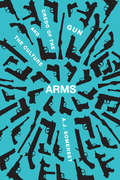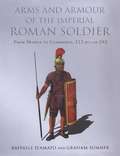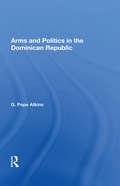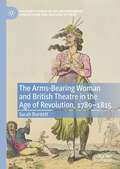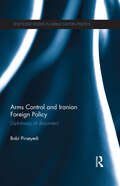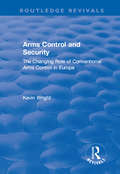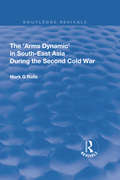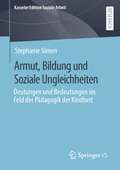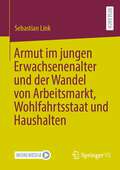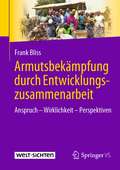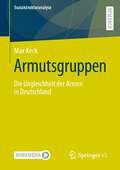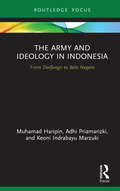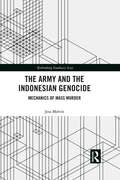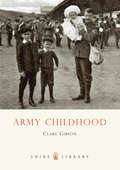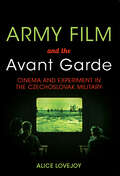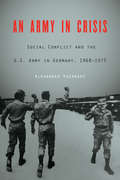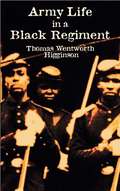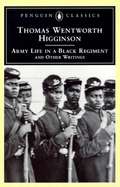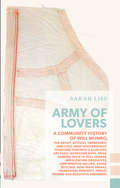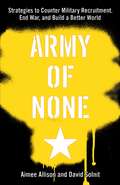- Table View
- List View
Armour and Masculinity in the Italian Renaissance
by Carolyn SpringerDuring the Italian Wars of 1494 to 1559, with innovations in military technology and tactics, armour began to disappear from the battlefield. Yet as field armour was retired, parade and ceremonial armour grew increasingly flamboyant. Displaced from its utilitarian function of defense but retained for symbolic uses, armour evolved in a new direction as a medium of artistic expression. Luxury armour became a chief accessory in the performance of elite male identity, coded with messages regarding the owner's social status, genealogy, and political alliances. Carolyn Springer decodes Renaissance armour as three-dimensional portraits through the case studies of three patrons of luxury armourers, Guidobaldo II della Rovere (1514-75), Charles V Habsburg (1500-58 and Holy Roman Emperor from 1519-56), and Cosimo I de'Medici (1519-74). A fascinating exposition of male self-representation, Armour and Masculinity in the Italian Renaissance explores the significance of armour in early modern Italy as both cultural artefact and symbolic form.
Arms: The Culture and Credo of the Gun
by Andrew SomersetIn Arms: the Culture and Credo of the Gun, novelist, journalist, sports shooter, and former army reservist A.J. Somerset offers up one of the first looks at the gun as our pre-eminent cultural symbol of power and asks how it got that way. <P><P>Pouring through the various cultural battlefields of 19th- and 20th-century North America, including film, literature, music, videos games, and history, Somerset charts how the gun went from a tool in the hands of the earliest pioneers, used to defend the homestead and put food on the table, to a kind of totem, instantly capable of dividing communities. Sharp-eyed and acerbic, sure-handed and sportive, Arms presents an intellectual and cultural history that is certain to enrage, entertain, and provoke debate, while showing that the gun cultures of Canada and the United States may not be so different after all. If guns, as the NRA often exclaims, do not kill people, Somerset shows how the idea of the gun has become something many believe worth dying for.
Arms and Armour of the Imperial Roman Soldier: From Marius to Commodus, 112 BC–AD 192
by Raffaele D'Amato Graham SumnerA survey of the various forms of armour worn by the Roman soldier from 112 BC to 192 AD, featuring a wealth of illustrations and plates. From the Latin warriors on the Palatine Hill in the age of Romulus, to the last defenders of Constantinople in 1453 AD, the weaponry of the Roman Army was constantly evolving. Through glory and defeat, the Roman warrior adapted to the changing face of warfare. Due to the immense size of the Roman Empire, which reached from the British Isles to the Arabian Gulf, the equipment of the Roman soldier varied greatly from region to region. Through the use of materials such as leather, linen and felt, the army was able to adjust its equipment to these varied climates. Arms and Armour of the Imperial Roman Soldier sheds new light on the many different types of armour used by the Roman soldier, and combines written and artistic sources with the analysis of old and new archaeological finds. With a huge wealth of plates and illustrations, which include ancient paintings, mosaics, sculptures and coin depictions, this book gives the reader an unparalleled visual record of this fascinating period of military history. This book, the first of three volumes, examines the period from Marius to Commodus. Volume II will cover the period from Commodus to Justinian, and Volume III will look at the period from Romulus to Marius. &“An impressive achievement, a testament to an enormous scholarly effort—and it is a significant contribution to the understanding of the Roman army.&” —Bryn Mawr Classical Review &“Without doubt, this is the definitive study of clothing, armour and weaponry worn by Roman soldiers during the golden age of their conquests...D&’Amato has brought together a remarkable collection of archaeological photographs gathered over decades to illustrate every aspect of this military evolution . . . A treasure trove of facts and illustrations that is essential reading for any Roman military enthusiast.&” —Tim Newark, Military Illustrated Magazine
Arms And Politics In The Dominican Republic
by G. Pope AtkinsThis chronicle and interpretation of recent military and political events in the Dominican Republic analyzes the political behavior of the country's armed forces and scrutinizes policies put in action since the nation's civil war and the subsequent U.S. intervention of 1965.
The Arms-Bearing Woman and British Theatre in the Age of Revolution, 1789-1815 (Palgrave Studies in the Enlightenment, Romanticism and Cultures of Print)
by Sarah BurdettThis book explores shifting representations and receptions of the arms-bearing woman on the British stage during a period in which she comes to stand in Britain as a striking symbol of revolutionary chaos. The book makes a case for viewing the British Romantic theatre as an arena in which the significance of the armed woman is constantly remodelled and reappropriated to fulfil diverse ideological functions. Used to challenge as well as to enforce established notions of sex and gender difference, she is fashioned also as an allegorical tool, serving both to condemn and to champion political and social rebellion at home and abroad. Magnifying heroines who appear on stage wielding pistols, brandishing daggers, thrusting swords, and even firing explosives, the study spotlights the intricate and often surprising ways in which the stage amazon interacts with Anglo-French, Anglo-Irish, Anglo-German, and Anglo-Spanish debates at varying moments across the French revolutionary and Napoleonic campaigns. At the same time, it foregrounds the extent to which new dramatic genres imported from Europe –notably, the German Sturm und Drang and the French-derived melodrama– facilitate possibilities at the turn of the nineteenth century for a refashioned female warrior, whose degree of agency, destructiveness, and heroism surpasses that of her tragic and sentimental predecessors.
Arms Control and Iranian Foreign Policy: Diplomacy of Discontent (Routledge Studies in Middle Eastern Politics)
by Bobi PirseyediSince 2003, when the world learned that the Islamic Republic of Iran had succeeded in secretly developing a capability to enrich uranium and separate plutonium, the question of Iran’s nuclear program has ranked high on the international political and arms control agenda. This book studies the IRI’s diplomatic operations in the issue area of arms control and demonstrates how arms control diplomacy has formed an integral part of the IRI’s foreign policy during the various phases of its history. Furthermore, it fills a gap in the research literature on Iran’s foreign and security policies by providing the first comprehensive account of Iranian arms control diplomacy under the Islamic regime. This book aims at reconstructing Iran’s diplomatic operations in four distinct thematic areas of arms control: conventional, chemical, biological, and nuclear arms control. It also looks at the diplomatic means by which the IRI’s leadership has tried to achieve its arms control objectives. This text also seeks to identify and examine the individual objectives that have guided Iranian policy choices in the domain of arms control. Finally, it places the reconstructed Iranian objectives into a broader context by elaborating on the fundamental values or foreign policy goals that the IRI’s arms control objectives have served. This highly informative and thought provoking volume will be valuable reading for students, researchers and academics, as well as for commentators and policy-makers interested in Middle East studies, Iranian studies, international relations and arms control.
Arms Control And The New Middle East Security Environment
by Shai Feldman Ariel LeviteThis volume incorporates the talks delivered at a conference on 11 Arms Control and the New Middle East Security Environment, 11 held in Ginosar (Israel) in January 1992. The conference was organized within the framework of the Project on Security and Arms Control in the Middle East conducted by Tel Aviv University's Jaffee Center for Strategic Studies. Some 28 scholars from eight different countries, together with some 30 Israelis, took part in the conference deliberations.
Arms Control and Security: The Changing Role of Conventional Arms Control in Europe (Routledge Revivals Ser.)
by Kevin WrightThis title was first published in 2000: The aim of this text is to explore conventional arms control in Europe. The early chapters provide a primarily historical perspective, looking at the context, foundations, main provisions and institutional structure of the main agreements. The later chapters explore the continuing and likely future roles of the OSCE and NATO in the arms control process. The final chapters examine more contemporary developments by looking at the Adapted CFE Treaty and Vienna Documents agreed at the OSCE Istanbul Summit in November 1998 and the challenges posed to existing arrangements by the changing and emergent security threats that potentially face Europe.
The Arms Dynamic in South-East Asia During the Second Cold War (Routledge Revivals)
by Mark. G RollsThis title was first publishd in 2002. This work uses the concept of the "arms dynamic" to identify and assess the various factors which influenced arms acquisitions of Southeast Asian states during the second Cold War period from 1979 to 1989, providing an essential basis for understanding contemporary developments. The book provides a comprehensive and systematic explanation of the reasons for arms purchases in SE Asia during the 1980s and aims to fill a gap in the literature by fully exploring arms procurement processes in the region prior to the end of the Cold War.
Arms Production In Japan: The Military Applications Of Civilian Technology
by Reinhard DrifteAlthough Japan's arms industry is still relatively small, significant political, economic, and technological developments indicate its growing importance and pave the way for Japan's increasing involvement in arms production. In this comprehensive study, Dr. Drifte examines both the domestic and international environments that are encouraging Japan
Armut, Bildung und Soziale Ungleichheiten: Deutungen und Bedeutungen im Feld der Pädagogik der Kindheit (Kasseler Edition Soziale Arbeit #27)
by Stephanie SimonIn dieser Arbeit werden Deutungen und Bedeutungen Sozialer Ungleichheiten im Feld der Pädagogik der Kindheit und damit verbunden mögliche Zusammenhänge zwischen Bildung und Armut aus der Perspektive pädagogischer Fachkräfte in Kindertageseinrichtungen sowie in wissenschaftlichen Publikationen qualitativ-rekonstruktiv untersucht. Im Zentrum stehen dabei ungleichheitstheoretische, wissenschaftstheoretische sowie professionstheoretische Fragestellungen, denen sich die Autorin über eine reflexive Analyseperspektive nähert. Herausgestellt wird, dass sowohl in der pädagogischen als auch in der wissenschaftlichen Praxis problematische Deutungsangebote in Bezug auf Zusammenhänge zwischen Armut und Bildung existieren, etwa Individualisierungen und Naturalisierungen sozialer Ungleichheiten.
Armut im jungen Erwachsenenalter und der Wandel von Arbeitsmarkt, Wohlfahrtsstaat und Haushalten
by Sebastian LinkSebastian Link geht in diesem Buch der Frage nach, welche Auswirkungen mit dem Erwerbseinstiegsprozess verbundene Risiken (Arbeitslosigkeit, Niedriglohnbeschäftigung) und atypische Beschäftigungsverhältnisse auf die Armutsbetroffenheit junger Erwachsener in Deutschland haben. Mithilfe von Quer- und Längsschnittanalysen auf Basis des Sozio-Oekonomischen Panels zeigt er, dass nicht in erster Linie das gehäufte Auftreten von Erwerbsrisiken und atypischer Beschäftigung zu einem Armutsanstieg bei jungen Erwachsenen geführt hat, sondern die Verstärkung ihrer negativen finanziellen Folgen. Diese Verstärkung steht in einem Zusammenhang mit dem abnehmenden Schutz junger Erwachsener vor Armut durch Wohlfahrtsstaat und Haushalte.
Armutsbekämpfung durch Entwicklungszusammenarbeit: Anspruch – Wirklichkeit – Perspektiven
by Frank BlissDieses Buch gibt eine Einführung in die Theorie und insbesondere die Praxis der entwicklungspolitischen Zusammenarbeit. Der Fokus liegt dabei auf der Armutsbekämpfung, d.h., das (häufig leider nur eingeschränkte) Bemühen von Regierungen der sogenannten Entwicklungsländer, die Massenarmut mit finanzieller und technischer Unterstützung vor allem der reichen Industrieländer zu reduzieren. Nach einer Problematisierung der zumeist unterschätzen Armutszahlen sowie Darlegung der Gründe für Armut und ihre Verstetigung erfolgt ein kurzer Überblick über die allgemeine Praxis der Entwicklungszusammenarbeit (Akteure, Gelder, Verfahren). Zahlreiche Projektbeispiele zeigen bisherige erfolgreiche wie auch weniger erfolgreiche Lösungen sowie die notwendigen Reformen bei der Armutsbekämpfung.Es werden die wichtigsten Bereiche der Zusammenarbeit berücksichtigt: die „klassischen“ Sektoren, angefangen von Bildung und Gesundheitsversorgung über den Ressourcenschutz, die Landwirtschaft, die Beschäftigungsförderung und natürlich die ganz besonders wichtige Trinkwasserversorgung. Sehr praktische und einleuchtende Beispiele beziehen sich auch auf die Regierungsarbeit („gute Regierungsführung“) und die Infrastruktur, denn Korruption kann alle Entwicklung verhindern und ohne wenigstens eine Piste vom Dorf zum Markt kann selbst ein Kleinbauer in Afrika nichts auf dem Markt verkaufen. Eine Reihe von mit Fotos dokumentierten Fallstudien runden das Praxisbild ab.
Armutsgruppen: Die Ungleichheit der Armen in Deutschland (Sozialstrukturanalyse)
by Max KeckDieses Buch beschäftigt sich auf Grundlage einer Kritik der Forschungspraxis quantitativer Armutsforschung mit der Heterogenität der Armutspopulation in Deutschland. Dies geschieht entlang von Armutsgruppen im Zeitraum von 1984 bis 2018 und unter Verwendung des Sozioökonomischen Panels (SOEP). Hierbei spielt eine kombinierte Analyse von Risikopositionen in der Erwerbsarbeit, in der sozialstaatlichen Umverteilung und in Haushalten eine Rolle. Die Ergebnisse der Arbeit sind sowohl für die Armutsforschung als auch für die Sozialberichterstattung interessant. Das Buch bietet aber auch für Praktiker*innen in politischen Feldern spannende Erkenntnisse.
The Army and Ideology in Indonesia: From Dwifungsi to Bela Negara (Routledge Contemporary Southeast Asia Series)
by Muhamad Haripin Adhi Priamarizki Keoni Indrabayu MarzukiThis book is an analysis of Indonesia’s civil-military relations in the post-1998 reform era. It focuses on the political thinking of the Indonesian Army during the time of democratic consolidation. The book examines the army (Tentara Nasional Indonesia Angkatan Darat, TNI AD), a pivotal player in the political scene of Indonesian state, and the aspect of military ideology development. Based on in-depth interviews with civilian and military figures and applying the methodology of utilised process tracing and empirical analysis surrounding the appearance of military thinking, the book argues that the Indonesian military pursues to sustain its political power by propagating a set of values construed as moral compass for all members of society. Specifically, the book discusses the origins and impacts of ‘proxy war’ and ‘bela negara’ (‘defend the state’), which was promoted by former TNI Commander Gatot Nurmantyo (2015-2017) and former Defence Minister Ryamizard Ryacudu (2014-2019). The authors demonstrate that both ideologies facilitate expansion of the military’s influence in all aspects of life and protection of its corporate interests in the age of democracy. Offering insights for theoretical discussion on the influence of military ideology to civil-military relations, particularly in the post-authoritarian period, this book will be of interest to academics and policy makers in the fields of Southeast Asian Politics, Asian Politics and Civil-Military Relations.
The Army and the Indonesian Genocide: Mechanics of Mass Murder (Rethinking Southeast Asia)
by Jess MelvinFor the past half century, the Indonesian military has depicted the 1965-66 killings, which resulted in the murder of approximately one million unarmed civilians, as the outcome of a spontaneous uprising. This formulation not only denied military agency behind the killings, it also denied that the killings could ever be understood as a centralised, nation-wide campaign. Using documents from the former Indonesian Intelligence Agency’s archives in Banda Aceh this book shatters the Indonesian government’s official propaganda account of the mass killings and proves the military’s agency behind those events. This book tells the story of the 3,000 pages of top-secret documents that comprise the Indonesian genocide files. Drawing upon these orders and records, along with the previously unheard stories of 70 survivors, perpetrators, and other eyewitness of the genocide in Aceh province it reconstructs, for the first time, a detailed narrative of the killings using the military’s own accounts of these events. This book makes the case that the 1965-66 killings can be understood as a case of genocide, as defined by the 1948 Genocide Convention. The first book to reconstruct a detailed narrative of the genocide using the army’s own records of these events, it will be of interest to students and academics in the field of Southeast Asian Studies, History, Politics, the Cold War, Political Violence and Comparative Genocide.
Army at Home: Women and the Civil War on the Northern Home Front
by Judith Ann GiesbergIntroducing readers to women whose Civil War experiences have long been ignored, Judith Giesberg examines the lives of working-class women in the North, for whom the home front was a battlefield of its own. Black and white working-class women managed farms that had been left without a male head of household, worked in munitions factories, made uniforms, and located and cared for injured or dead soldiers. As they became more active in their new roles, they became visible as political actors, writing letters, signing petitions, moving (or refusing to move) from their homes, and confronting civilian and military officials. At the heart of the book are stories of women who fought the draft in New York and Pennsylvania, protested segregated streetcars in San Francisco and Philadelphia, and demanded a living wage in the needle trades and safer conditions at the Federal arsenals where they labored. Giesberg challenges readers to think about women and children who were caught up in the military conflict but nonetheless refused to become its collateral damage. She offers a dramatic reinterpretation of how America's Civil War reshaped the lived experience of race and gender and brought swift and lasting changes to working-class family life.
Army Childhood
by Clare GibsonAn army childhood is a peripatetic childhood. Taking the Napoleonic Wars as its starting point, Army Childhood sheds light on such crucial aspects of the army-child experience as the places that the children of British Army soldiers have called home, and on how they have been transported, housed, cared for, educated and entertained after the army assumed responsibility for their welfare. This informative and evocatively illustrated book will appeal to those interested in British military history's social side, and to those seeking to understand what life was like for an erstwhile army-child ancestor. It is also essential reading for those who were once themselves 'barrack rats', 'pads' brats', or 'army brats', in whom it is guaranteed to arouse nostalgic memories.
Army Film and the Avant Garde: Cinema And Experiment In The Czechoslovak Military
by Alice Osborne LovejoyDuring the 1968 Prague Spring and the Soviet-led invasion and occupation that followed, Czechoslovakia's Army Film studio was responsible for some of the most politically subversive and aesthetically innovative films of the period. Although the studio is remembered primarily as a producer of propaganda and training films, some notable New Wave directors began their careers there, making films that considerably enrich the history of that movement. Alice Lovejoy examines the institutional and governmental roots of postwar Czechoslovak cinema and provides evidence that links the Army Film studio to Czechoslovakia's art cinema. By tracing the studio's unique institutional dimensions and production culture, Lovejoy explores the ways in which the "military avant-garde" engaged in dialogue with a range of global film practices and cultures. (The print version of the book includes a DVD featuring 16 short films produced by the Czechoslovak Ministry of Defense. The additional media files are not available on the eBook.)
An Army in Crisis: Social Conflict and the U.S. Army in Germany, 1968–1975
by Alexander VazanskyFollowing the decision to maintain 250,000 U.S. troops in Germany after the Allied victory in 1945, the U.S. Army had, for the most part, been a model of what a peacetime occupying army stationed in an ally’s country should be. The army had initially benefited from the positive results of U.S. foreign policy toward West Germany and the deference of the Federal Republic toward it, establishing cordial and even friendly relations with German society. By 1968, however, the disciplined military of the Allies had been replaced with rundown barracks and shabby-looking GIs, and U.S. bases in Germany had become a symbol of the army’s greatest crisis, a crisis that threatened the army’s very existence. In An Army in Crisis Alexander Vazansky analyzes the social crisis that developed among the U.S. Army forces stationed in Germany between 1968 and 1975. This crisis was the result of shifting deployment patterns across the world during the Vietnam War; changing social and political realities of life in postwar Germany and Europe; and racial tensions, drug use, dissent, and insubordination within the U.S. Army itself, influenced by the civil rights movement, the Vietnam War, and the youth movement in the States. With particular attention to 1968, An Army in Crisis examines the changing relationships between American and German soldiers, from German deference to familiarity and fraternization, and the effects that a prolonged military presence in Germany had on American military personnel, their dependents, and the lives of Germans. Vazansky presents an innovative study of opposition and resistance within the ranks, affected by the Vietnam War and the limitations of personal freedom among the military during this era.
Army Life in a Black Regiment (Civil War)
by Thomas Wentworth Higginson"Army Life in a Black Regiment has some claim to be the best written narrative to come from the Union [side] during the Civil War. Higginson's picture of the battle which was the origin of "praise the Lord and pass the ammunition" and his reading of the Emancipation Proclamation to the black regiment are unsurpassed for eloquence." — historian Henry Steele CommagerOriginally a series of essays, this important volume was written by a Union colonel from New England, in charge of African-American troops training on the Sea Islands off the coast of the Carolinas. A lively and detailed wartime diary, the book offers a refreshing portrait of life in the Union Army from an officer's point of view, recording opinions of other commanders and capturing the raw humor that develops among the men in combat. Higginson's descriptions of the soldiers, routines of camp life, and southern landscapes are unforgettable, as is the account of his near escape from a cannon ball. An unusual historical document intended to introduce new generations of readers to an American past that should not be forgotten, Army Life in a Black Regiment will be invaluable to students of Black History and the American Civil War.
Army Life in a Black Regiment and Other Writings
by Thomas Wentworth HigginsonA stirring account of wartime experiences from the leader of the first regiment of emancipated slavesThomas Wentworth Higginson, a Unitarian minister, was a fervent member of New England's abolitionist movement, an active participant in the Underground Railroad, and part of a group that supplied material aid to John Brown before his ill-fated raid on Harpers Ferry. When the Civil War broke out, Higginson was commissioned as a colonel of the black troops training in the Sea Islands off the coast of the Carolinas. Shaped by American Romanticism and imbued with Higginson's interest in both man and nature, Army Life in a Black Regiment ranges from detailed reports on daily life to a vivid description of the author's near escape from cannon fire, to sketches that conjure up the beauty and mystery of the Sea Islands. This edition of Army Life features as well a selection of Higginson's essays, including 'Nat Turner's Insurrection' and 'Emily Dickinson's Letters. ''Has some claim to be the best written narrative to come from the Union during the Civil War. '- Henry Steele CommagerIntroduction and Notes by R. D. MADISON
Army Nurse Corps Voices from the Vietnam War: Eight Women, One War (Palgrave Studies in Oral History)
by Janet D. TannerThis book provides an oral history of women who served in the U.S. Army Nurse Corps during the Vietnam War. It follows the trajectory of eight women’s lives from their decision to become nurses, to surgical and evacuation hospitals in Vietnam, and then home to face the consequences of war on their personal and professional lives. It documents their lived experience in Vietnam and explores the memories and personal stories of nurses who treated injured American soldiers, Vietnamese civilians, and the enemy. Their voices reveal the physical and emotional challenges, trauma, contradictions, and lingering effects of war on their lives. Women in the U.S. Army in Vietnam feared the enemy but also sexual violence and harassment: the experiences this book documents also shed light on the extent of historical sexual abuse in the military.
Army of Lovers: A Community History of Will Munro
by Sarah LissIn the spring of 2010, Toronto lost one of its most important queer civic heroes. Weaving together interviews and stories, Army of Lovers is a biography of Will Munro and a document of a galvanizing period when various subcultures - the queer community, the art scene, the independent music universe, the grassroots activist enclaves - came together.
Army of None: Strategies to Counter Military Recruitment, End War, and Build a Better World
by David Solnit Aimee AllisonUniformed U.S. Army Officers lunch with students in elementary school cafeterias. Army training programs including rifle and pistol instruction replace physical education in middle schools. Like never before, military recruiters are entering the halls of U.S. schools with unchecked access in an attempt to bolster a military in crisis.However, even as these destructive efforts to militarize youth accelerate, so do the creative and powerful efforts of students, community members, and veterans to challenge them. Today, the counter recruitment movement--from counseling to poetry slams to citywide lobbying efforts--has become one of the most practical ways to tangibly resist U.S. policy that cuts funding for education and social programs while promoting war and occupation. Without enough soldiers, the U.S. cannot sustain its empire.Army of None exposes the real story behind the military-recruitment complex, and offers guides, tools, and resources for education and action, and people power strategies to win.

